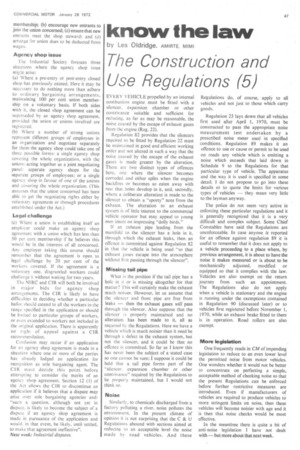know the law
Page 49

If you've noticed an error in this article please click here to report it so we can fix it.
by Les Oldridge, AMIRTE, MIMI
The Construction and Use Regulations (5)
EVERY VEHICLE propelled by an internal combustion engine must be fitted with a silencer. expansion chamber or other contrivance suitable and sufficient for reducing. as far as may be reasonable, the noise caused by the escape of exhaust gases from the engine (Reg. 22).
Regulation 82 provides that the silencers required to be fitted by Regulation 22 must be maintained in good and efficient working order and not altered in such a way that the noise caused by the escape of the exhaust gases is made greater by the alteration. There are two distinct types of offences here, one where the silencer becomes corroded and either splits when the engine backfires or becomes so eaten away with rust that holes develop in it, and, secondly, where a deliberate alteration is made to the silencer to obtain a "sporty" note from the exhaust. The alteration to an exhaust system is of little interest to the commercial vehicle operator but may appeal to young men intent on impressing "dolly birds."
If an exhaust pipe leading from the manifold to the silencer has a hole in it, through which the exhaust leaks, then, an offence is committed against Regulation 82 in that the vehicle is being used "so that exhaust gases escape into the atmosphere without first passing through the silencer".
Missing tail pipe
What is the position if the tail pipe has a hole in it or is missing altogether for that matter? This will certainly make the exhaust much noisier. However, let us assume that the silencer and front pipe are free from leaks — then the exhaust gases will pass through the silencer. Also suppose that the silencer is properly maintained and no alteration has been made to it, all as required by the Regulations. Here we have a vehicle which is much noisier than it need be through a defect in the exhaust system, but not the silencer, and it could be that no offence is committed. So far as I know this has never been the subject of a stated case so one cannot be sure; I suppose it could be held that a tail pipe forms part of the "silencer. expansion chamber or other contrivance" required by the Regulations to be properly maintained, but I would not think so.
Noise
Similarly, to chemicals discharged from a factory polluting a river, noise pollutes the environment. In the present climate of opinion it is not surprising that the C & U Regulations abound with sections aimed at reducing to an acceptable level the noise made by road vehicles. And these
Regulations do, of course, apply to all vehicles and not just to those which carry goods.
Regulation 23 lays down that all vehicles first used after April 1, 1970, must be constructed to pass the appropriate noise measurement test undertaken by a prescribed noise meter used in specified conditions. Regulation 89 makes it an offence to use or cause or permit to be used on roads any vehicle which is emitting a noise which exceeds that laid down in Schedule 9 to the Regulations for that particular type of vehicle. The apparatus and the way it is used is specified in some detail. I do not propose to go into these details or to quote the limits for various types of vehicles — they mean very little to the layman anyway.
The police do not seem very active in enforcing these particular regulations and it is generally recognized that it is a very difficult and complex subject. Some Chief Constables have said the Regulations are unenforceable. In case anyone is reported for an offence against regulation 89 it is useful to remember that it does not apply to a vehicle proceeding to a place where, by previous arrangement, it is about to have the noise it makes measured or is about to be mechanically adjusted, modified or equipped so that it complies with the law. Vehicles are also exempt on the return journey from such an appointment. The Regulations also do not apply when a vehicle is stationary and the engine is running under the exemptions contained in Regulation 90 (discussed later) or to vehicles first registered before November 1, 1970, while an exhaust brake fitted to them is in operation. Road rollers are also exempt
More legislation
One frequently reads in CM of impending legislation to reduce to an even lower level the permitted noise from motor vehicles. One wonders whether it would not be better to concentrate on perfecting a simple, acceptable method of checking noise so that the present Regulations can be enforced before further restrictive measures are introduced. Even if manufacturers of vehicles are required to produce vehicles to more stringent limits on noise, then these vehicles will become noisier with age and it is then that noise checks would be most effective.
In the meantime there is quite a bit of anti-noise legislation I have not dealt with — but more about that next week.
























































































